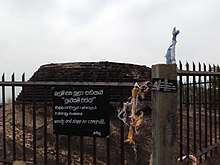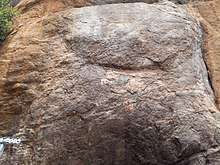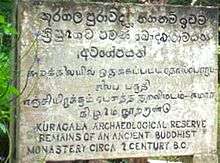Kuragala
| Kuragala Ancient Buddhist Monastery | |
|---|---|
| කූරගල පුරාණ බෞද්ධ අාරාම සංකීර්ණය | |
 A view of Akasha Chaitya at Kuragala | |
| Basic information | |
| Location | Balangoda |
| Geographic coordinates | 06°37′44.4″N 80°51′51.9″E / 6.629000°N 80.864417°ECoordinates: 06°37′44.4″N 80°51′51.9″E / 6.629000°N 80.864417°E |
| Affiliation | Buddhism |
| District | Ratnapura |
| Province | Sabaragamuwa Province |
| Country | Sri Lanka |
| Heritage designation | Archaeological reserve |
| Architectural description | |
| Architectural type | Buddhist Temple |
| Architectural style | Cave temple |
| Completed | circa 2 century BC |
Kuragala (Sinhalese: කූරගල) is a pre-historic archaeological site with ruins of ancient Buddhist Cave temple complex, dating back to the 2nd century BC, in Balangoda, Sri Lanka. The temple complex is located on the Balangoda - Kaltota road (B38) approximately 24 km (15 mi) distance from the Balangoda town. The site has been formally recognised by the Government as an archaeological reserve in Sri Lanka. Kuragala is considered as the oldest archaeological site found in the Intermediate Zone.[1]
History
Pre-historic evidences
According to the archaeological evidences found, Kuragala area had been used by humans belonging to the pre-historic period.[2] From the excavations, archaeologists found stone tools, fossilized bone fragments and remains of a human skeleton which is believed to be aged more than 8,000 years.[3][4] Investigations further revealed that the humans lived in Kuragala may had close links with the coastal areas as it found the remnants of seashells and shells of clams.[3] Recent studies done in the Kuragala Kaltota Diyawinna area have revealed that beside the hunting, they had also engaged in agricultural activities as well.[5]
Buddhist monastery

The extensive investigations, carried out by the archaeological department at the Kuragala, uncovered evidences that the caves at the site were using as a Buddhist monastery during the period between 3rd century BC and first century AD.[3][7] An archaeological report on Kuragala area, published by C.H. Collins in 1932, documents about the two cave shelters and 2nd century BC Brahmi inscriptions as well as about the carved stone lintels, stairways and platforms, located at the foot of the Kuragala brae (Budugala area). From eye copies, C. H Collins published his interpretations of Kuragala inscriptions in JRASCB, XXXII, 1932. These inscriptions were reread, and republished in Inscriptions of Ceylon Vol. I by the archaeological department.[8]
Researches done by Sri Lankan archaeologists and epigraphers have established that, inscribed cave shelters were made for Buddhist monks by donors as religious donations.[9] Caves provide shelter to them during the annual rainy season retreat as prescribed in Theravada Buddhist tradition. Existence of dripledged caves in a site indicate that they were inhabited by Bhikkhus during the past period and epigraphs further reveal the names of donors who donate the prepared caves to them.
At the summit of the Kuragala is a brick built Stupa which is now an archaeologically protected monument. The Stupa is considered belongs to the tradition of Akasa Chaithya which type of Stupa were built since 7th century CE to serve as communication beacons giving directions.[10] The present Stupa has been restored on the location where the residue of ancient Stupa was identified. However some allege that the Stupa at Kuragala is a modern construction, built using local bricks and Kankesanthurai cement, and the construction was stopped half as Jailani trustees obtain a cabinet order.[11]

Muslim shrine
It was lead to tensions after Muslims started to claim the site.[12] From the end of 19th century the site was claimed to be occupied by the Muslim people and said to be maintained as a Sufi shrine named Daftar Jailani rock cave mosque by Muslims. According to the alleged local Muslim's believes a Sufi saint called Sheikh Muhiyadeen Abdul Qadir Jilani (d. 1166 CE, buried in Baghdad) have stayed in this place for 12 years after paying his respects to Adam's Peak.[13][7] However the shrine itself preserves no physical trace of the saint[14], an inscription written in Arabic language has been said to be found in the site which has not yet accepted to be historical by the authorities.[15] According to a self-published book by the late chief trustee of Jailani, M.L.M. Aboosally, this inscription is belonged to 907 CE, a date more than two centuries prior to the saint’s lifetime.[16]
References
- ↑ "Kuragala recognised the oldest archaeological site in Intermediate Zone". The Island (Sri Lanka). Upali Newspapers. 20 May 2014. Retrieved 24 September 2017.
- ↑ "PM promises to conserve Kuragala site without allowing it to become communal issue". The Island (Sri Lanka). Upali Newspapers. 22 October 2015. Retrieved 24 September 2017.
- 1 2 3 "'Don't create religious issues based on Kuragala' - DG of Archaeology". The Official Government News Portal of Sri Lanka. Retrieved 24 September 2017.
- ↑ "Govt. to conduct archaeological fact-finding mission in Kuragala". Daily FT. Wijeya Newspapers. 23 October 2015. Retrieved 24 September 2017.
- ↑ "Startling new evidence on pre-historic man found in Kuragala (Video)". News First. 10 April 2014. Retrieved 24 September 2017.
- ↑ JRASCB XXXII:167; ASCAR 1961-62:82; Paranavitana 1970:774-776
- 1 2 "Kuragala Controversy Deepens". The Sunday Leader. Leader Publications. 31 May 2015. Retrieved 24 September 2017.
- ↑ "What Paranavitana said to McGilvray: 'Do your homework son'". The Nation (Sri Lanka). Rivira Media Corporation (Pvt) Ltd. 4 August 2013. Retrieved 24 September 2017.
- ↑ McGilvray, Dennis B. (2016). Islam, Sufism and Everyday Politics of Belonging in South Asia (edited by Deepra Dandekar and Torsten Tschacher). Taylor & Francis. p. 67. ISBN 9781317435969.
However, research by Sri Lankan archaeologists and epigraphers establishes that such inscribed caveshelters were intended by their donors as religious gifts to support the monkhood in Sri Lanka, providing shelter during the annual rainy season (vassa) retreat as prescribed in Theravada Buddhist tradition (Paranavitana 1970; Dias 2001: 14–18)
- ↑ ""I had no intention of resolving any conflict at Kuragala" Prof. Raj Somadeva says". The Nation (Sri Lanka). Rivira Media Corporation (Pvt) Ltd. 6 June 2015. Retrieved 25 September 2017.
- ↑ Ahmad, Reifeld 2004, p. 287.
- ↑ "LankaWeb – ICC: Destroying shrines is a war crime – Sinhala Buddhists must showcase the war crimes committed by LTTE-TNA & Muslim fundamentalists". Retrieved 2018-04-05.
- ↑ "Kuragala: Buddhist Sacred Site Or Sufi Shrine? | The Sunday Leader". www.thesundayleader.lk. Retrieved 2018-04-05.
- ↑ McGilvray, Dennis B. (2016). Islam, Sufism and Everyday Politics of Belonging in South Asia (edited by Deepra Dandekar and Torsten Tschacher). Taylor & Francis. p. 63. ISBN 9781317435969.
The shrine itself preserves no physical trace of the saint; it is instead a hermitage site where his annual kandoori death anniversary festival (Tamil, kantūri, equivalent of ‘urs) is celebrated
- ↑ "LankaWeb – Kuragala Buddhist Heritage and Archaeological Sites Must be Reinstated". Retrieved 2018-04-05.
- ↑ Aboosally, M.L.M. (2002). Dafther Jailany: A Brief Account of the Dafther Jailany Rock Cave Mosque in Balangoda, Sri Lanka. Self published. p. 60-1. ISBN 9789559780106.